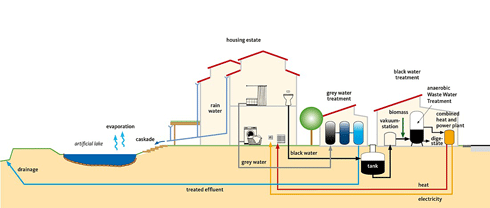
|
Published: 12 November 2012
In future, let’s build our cities around water
If you could build a city for one million people from scratch, which infrastructure should you put on the drawing board first? This question, as far as Monash Water for Liveability CEO Rob Skinner is concerned, has only one answer – the plumbing.
‘Cities are built around transport and employment needs. Only afterwards comes the question: how do we plumb in the water system?’ says Professor Skinner, who plays a pivotal role in the International Water Association’s (IWA) Cities of the Future program.
Prof. Skinner warns that if we don’t change this approach, our expanding cities will be at serious risk of locking in a pattern of design and development that means more expensive water supply and increased environmental damage.
Experts predict that the world’s cities combined will gain almost one million extra people a week leading up to 2050. Already, 68 per cent of Australia’s population live in cities; by 2050, this figure is expected to reach 80 per cent.
In some of the world’s cities, pipelines are losing 50 per cent of their water through leaks. In developing countries, poor water infrastructure is compounding already-dire sanitation issues.
Population and water supply issues are even more critical for Asian cities. Asia currently has 13 ‘megacities’ – cities with at least 10 million people. By 2025, it will have gained another nine.
Steve Moddemeyer – head of the sustainable development practice for Seattle-based architecture and planning firm CollinsWoerman, and a leader of the IWA’s Cities of the Future program – says population growth and outdated infrastructure models are on a collision course.
‘We are building cities at breakneck pace, particularly in the developing world. The problem is that we’re building the wrong kind of water infrastructure for the 21st century. We’re using models from the 19th and 20th centuries,’ he says.
The challenge to supply enough safe water to our growing cities is invoking a quiet revolution among water professionals and engineers across the globe – a revolution in which water management, treatment and delivery practices are being overhauled.
‘The Cities of the Future program is about recognising the issues that cities are facing, and looking for the new models that are doing a better job at building resilience,’ explains Mr Moddemeyer.
Building resilience means managing water flow so that a city can withstand both extremely dry and wet times. But, it is far more complex than just laying new pipes or constructing dams.
Delegates at 2010’s IWA World Water Congress in Montreal agreed on a vision for future city water planning. They drew up 12 planning principles that position water as central to a city’s ability to develop sustainably.
At this year’s IWA Congress in Korea, delegates identified 10 challenges that cities will need to deal with to realise these 12 principles.
‘The most critical challenges for existing cities are the institutional arrangements, regulations and underlying culture of water management agencies,’ says Prof. Skinner.
The revolution in the water sector considers water differently than in the past, when all water needed to be of a set quality standard. Industry experts are now talking about water being ‘fit for purpose’. This means that high-quality water is provided for drinking, but stormwater and recycled water of a lower quality are increasingly used to water parks and gardens.
Seeing water as fit for purpose means that not all water needs to go through the stringent and energy-guzzling filtration processes needed to produce drinking water.
Instead, it makes better use of the various water resources already found in cities and saves on energy and other inputs.

|
|
In 2008, Melbourne Water launched an ambitious program to establish 10,000 new rain gardens. Rain gardens capture stormwater runoff from impervious surfaces, and slow the rate and volume of water flushing through drains into rivers and creeks. They also promote healthier waterways by filtering pollution and add to the attraction and liveability of the city. Credit:
Associate Professor Peter Breen
|
Melbourne drought a wake-up call
With almost 4.5 million people, Melbourne is Australia’s second-largest city. It is a global pioneer of the urban water revolution, having been one of the first cities to recognise the IWA’s 12 principles.
The city has access to what many consider ‘dream’ water catchments that afford a relatively cheap and high-quality water supply. However, the drought of the past decade, which almost emptied Melbourne’s reservoirs, has woken many residents to the importance of water.
‘During the drought, parks and trees were dying. Only a quarter of our football or cricket fields could be watered, meaning three-quarters of our sports facilities were unsafe to play on,’ says Prof. Skinner. ‘Suddenly, there was a wake-up call that liveability in Melbourne meant healthy waterways and green spaces.’
The city’s response was to build Australia’s largest desalination plant to treat seawater and brackish water, and pipe drinkable water 84 kilometres to the city.
‘It will stand Melbourne in good stead, but we don’t want to be in a situation again where we have to build another desalination plant,’ Prof. Skinner states. ‘Desalination provides water security and reduces the otherwise singular reliance on dams for water supply, but it is an option that primarily focuses on the single need of water supply.’
For the past three years, Victorian government bodies and water utilities have shifted their focus from traditional centralised water supply and wastewater disposal. The state’s water industry is now gearing itself up for a system that values all water as fit for purpose, and integrates it from various sources, such as rainwater, stormwater runoff and recycled sewage.
In 2011, a Victorian ministerial advisory council noted that while Melbourne reused 31 billion litres of treated wastewater and stormwater in 2010 – representing 7.5 per cent of the total water demand – significant scope remains to increase the use of fit-for-purpose resources.
With the city’s population projected to reach 6.4 million by mid-century, annual demand for drinking water will increase by about 150 per cent. But over the past 15 years, average inflows into the city’s main reservoirs have been one-third less than the previous 80 years.
‘There is now a sense of urgency to reform the way water is valued, planned for and managed in Melbourne,’ says Prof. Skinner.
Decentralising supply
Paul Reiter, Executive Director of the IWA, says water planners will need to decentralise water supply systems to build resilience.
‘Water systems can be built into a 2000-unit housing network,’ he says. ‘In Europe, this might be 10,000 – it may be more in other cities. But, building bigger systems of centralised services will lead to infrastructure capacity failures.’
Other cities around the world pioneering the water revolution have embraced smaller-scale urban planning solutions.
In Hamburg, a former military base has been converted into an urban space for 630 homes. The water utility supplier, Hamburg Wasser, saw an opportunity to link three traditionally separate utilities. The homes are heated from waste that is converted to fuel; the separation of stormwater in the drainage infrastructure is used to irrigate the green open spaces.

|
|
The Jenfelder Au in Hamburg integrates water, wastewater and energy supplies. Credit:
Hamburg Wasser
|
Dense parts of Philadelphia have been retrofitted with stormwater capture systems, such as rain gardens, to help alleviate contaminated water entering the city’s natural waterways. And, Copenhagen has improved the ecological health of its harbour and the city’s liveability by reducing wastewater discharge from sewers and industrial companies.
‘Every area is different in terms of climate, geography, population density and closeness to existing central services,’ explains Prof. Skinner.
‘So, when you decide to redevelop or develop, you have to consider what the fit-for-purpose options are for each area. There may well be a more efficient way of serving those semi-centralised areas. Sometimes it is stormwater capture, sometimes it is recycled water, and sometimes it is the centrally supplied service.’
The IWA’s 12 principles for future city water planning are: |
|
The 10 challenges that cities will need to overcome are: |
|




